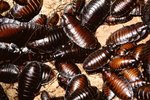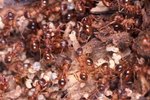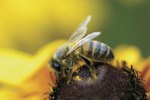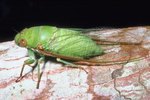
Africanized honey bees (Apis mellifera scutellata) are hybrid insects that came about due to the interbreeding of European honey bees and African bees. Killer bee is another common moniker for them, as they often behave aggressively toward others that invade their turf. Encounters with Africanized honey bees can sometimes lead to fatal consequences in people. Though these bees can be fierce, their life spans are typically extremely brief.
Tiers of Africanized Honey Bees
The Africanized honey bee realm is made up of three distinct tiers -- queens, drones and workers. Colonies are comprised of single queens, many drones and countless workers. Colony populations usually range from between 20,000 and 90,000 individuals.
Differentiating between queens, drones and workers is often possible if you take size into consideration. Queens are the biggest, and often can grow to lengths of 0.78 inch. Workers are the smallest, and can grow to a little less than 1/2 inch. The drones are usually somewhere in the middle of queens and workers, size-wise.
Typical Life Spans
Africanized honey bees' life spans generally depend on their tiers. Queens have the most longevity by far. These fertile specimens are capable of surviving for anywhere between one and three years. The drones have markedly shorter average life spans of between five and 10 weeks. Lastly, worker bees have the shortest lives of them all, with typical lengths of around one month.
Life of an Africanized Honey Bee
The life of an Africanized honey bee goes through several developmental stages. They start off as eggs, and then transition into larvae, pupae and then finally, mature specimens. Gender determination occurs when Africanized honey bees are mere eggs. Eggs that are fertilized become female workers, while those that aren't grow into male drones.
Possibility of Predation
Predation can greatly interfere with an Africanized honey bee's life span. Their usual predators aren't too different from those of other varieties of honey bees. People are their biggest threats. Other risks for their life spans include a host of creatures such as armadillos, anteaters, bears, parasitic mites, driver ants and honey badgers.
Strong Resemblance to European Honey Bees
Identifying an Africanized honey bee isn't exactly an easy task. They're practically identical to European honey bees -- major parts of their lineage. Experts can pinpoint Africanized honey bees by conducting genetic evaluations, however.
References
- Encyclopedia Smithsonian: Killer Bees
- University of Florida IFAS Entomology & Nematology: Africanized Honey Bee
- California Department of Food and Agriculture: Africanized Honeybee Pest Profile
- The Ohio State University Extension: Africanized Honey Bee
- University of Illinois Laboratory High School: Africanized Bees (Killer Bees)
- Utah State University Cooperative Extension: Africanized Honey Bees
- Arizona State University School of Life Sciences: Mite "Mighty" Foe to Killer Bees in State
- Columbia University Introduced Species Summary Project: Africanized Honey Bee
Photo Credits
-
Hemera Technologies/AbleStock.com/Getty Images




